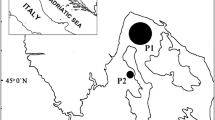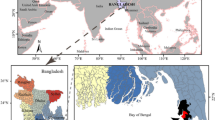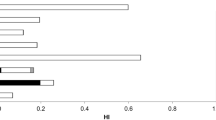Abstract
The present study focused on the distribution of some major and trace elements (S (as SO42−), Na, K, B, Ca, Mg, F, Li, Al, Fe, Zn, Cu, Mn, Ni, Co, Cd, and Pb) in both flesh (Fl) and total cephalon/exoskeleton (C/E) tissues of selected crustacean species obtained from an Egyptian traditional seafood marketing region. The sequence of studied elements in (Fl) and (C/E) tissues in descending orders was S (as SO42−) > Na > K > B > Mg > Ca > Li > F > Al > Zn > Fe > Cu > Pb > Ni > Mn > Co > Cd, and S (as SO42−) > Na > B > K > Mg > Ca > F > Li > Al > Fe > Cu > Zn > Mn > Pb > Ni > Co > Cd, respectively. Both length-weight relationship and Fulton’s condition factor showed the physical and biological statuses of the crustaceans. Ion quotient calculations of the studied tissues pointed to their importance in decreasing hypertension, preeclampsia, and heart disease. Human health risk due to the consumption of the crustacean species was determined using some guideline limits, metal pollution index (MPI), estimated daily intake (EDI), health comparison values (CVs), dietary intake (DRI-ULs), target hazard quotient (THQ), total target hazard quotient (TTHQ), and provisional tolerable weekly intake (%PTWI). MPI values of cephalon/exoskeleton tissues were greater than those of the flesh with ranges between 11.4–24.0 and 4.6–14.3, respectively. Interestingly, the calculations of TTHQ of toddler and adult were lesser than one and not expected to pose any risk concern to human from crustaceans’ consumption.




Similar content being viewed by others
References
Mitra A, Mondal K, Banerjee K (2010) Concentration of heavy metals in fish juveniles of Gangetic Delta of West Bengal, India. Res J Fish Hydrobiol 5(1):21–26
Bahnasawy M, Khidr A, Dheina N (2011) Assessment of heavy metal concentrations in water, plankton, and fish of Lake Manzala, Egypt. Turk J Zool 35(2):271–280
Brahmia Z, Scheifler R, Crini N, Maas S, Giraudoux P, Benyacoub S (2013) Breeding performance of blue tits (Cyanistes cæruleus ultramarines) in relation to lead pollution and nest failure rates in rural, intermediate, and urban sites in Algeria. Environ Pollut 174:171–178
Lu Y, Yin W, Huang LB, Zhang ZY (2011) Assessment of bioaccessibility and exposure risk of arsenic and lead in urban soils of Guangzhou City, China. Environ Geochem Health 33(2):93–102
Diodato S, Comoglio L, Camilión C, Amin O (2012) Responses of the resident rocky crab (Halicarcinus planatus, Decapoda) to natural stressors and effluent discharges in Ushuaia Bay, Tierra del Fuego, Argentina. J Exp Mar Biol Ecol (436-437):11–18. https://doi.org/10.1016/j.jembe.2012.08.011
Raknuzzaman M, Ahmed MK, Islam MS, Habibullah-Al-Mamun M, Tokumura M, Sekine M, Masunaga S (2016) Trace metal contamination in commercial fish and crustaceans collected from coastal area of Bangladesh and health risk assessment. Environ Sci Pollut Res 23(17):17298–17310
Abdul Baki M, Hossain MM, Akter J, Quraishi SB, Haque Shojib MF, Atique Ullah AKM, Khan MF (2018) Concentration of heavy metals in seafood (fishes, shrimp, lobster and crabs) and human health assessment in Saint Martin Island, Bangladesh. Ecotoxicol Environ Saf 159:153–163
Anual ZF, Maher W, Krikowa F, Hakim L, Ahmed NI, Foster S (2018) Mercury and risk assessment from consumption of crustaceans, cephalopods and fish from West Peninsular Malaysia. Microchem J 140:214–221
Heidarieh M, Maragheh MG, Shamami MA, Behgar M, Ziaei F, Akbari Z (2013) Evaluate of heavy metal concentration in shrimp (Penaeus semisulcatus) and crab (Portunus pelagicus) with INAA method. Springerplus 2(1):72. https://doi.org/10.1186/2193-1801-2-72
Krishnamurti AJ, Nair VR (1999) Concentration of metals in shrimps and crabs from thane-Bassein creek system, Maharastra. Indian J Mar Sci 28:92–95
Fuentes A, Fernández-Segovia I, Escriche I, Serra JA (2009) Comparison of physico-chemical parameters and composition of mussels (Mytilus galloprovincialis Lmk.) from different Spanish origins. Food Chem 112(2):295–302
Özden O, Ulusoy S, Erkan N (2010) Study on the behavior of the trace metal and macro minerals in Mytilus galloprovincialis as a bioindicator species: the case of Marmara Sea, Turkey. J Verbr Lebensm 5(3–4):407–412
Cederholm T (2017) Fish consumption and omega-3 fatty acid supplementation for prevention or treatment of cognitive decline, dementia or Alzheimer’s disease in older adults–any news? Curr Opin Clin Nutr Metab Care 20(2):104–109
Fakhri Y, Mohseni-Bandpei A, Oliveri Conti G, Ferrante M, Cristaldi A, Jeihooni AK, Karimi Dehkordi M, Alinejad A, Rasoulzadeh H, Mohseni SM, Sarkhosh M, Keramati H, Moradi B, Amanidaz N, Baninameh Z (2018) Systematic review and health risk assessment of arsenic and lead in the fished shrimps from the Persian gulf. Food Chem Toxicol 113:278–286
Mazrouh MM, Mourad MH (2019) Biochemical composition and bioaccumulation of heavy metals in some seafood in the Mediterranean Coast of Egypt. Egypt J Aqua Biol Fish 23(1):381–390
Alves RN, Maulvault AL, Barbosa VL, Marques A, Fernandez-Tejedor M, Tediosi A et al (2018) Oral bioaccessibility of toxic and essential elements in raw and cooked commercial seafood species available in European markets. Food Chem 267:15–27
Wang H, Cai D, Li K, Xu H, Yang L, Zhu N (2012) Effects of different calcium, magnesium, and zinc concentrations supplemented on hepatopancreatic cell proliferation of Kuruma prawn, Penaeus japonicas. Biol Trace Elem Res 148(2):198–202
Masoud MS, El-Sarraf WM, Harfoush AA, El-Said GF (2006) The effect of fluoride and other ions on algae and fish of coastal water of Mediterranean Sea, Egypt. Am J Environ Sci 2(2):49–59
Dreyfuss JL, Regatieri CV, Jarrouge TR, Cavalheiro RP, Sampaio LO, Nader HB (2009) Heparan sulfate proteoglycans: structure, protein interactions and cell signaling. An Acad Bras Ciênc 81(3):409–429
Institute of Medicine (IOM) (2003) Dietary reference intakes: applications in dietary planning. Subcommittee on Interpretation and Uses of Dietary Reference Intakes and the Standing Committee on the Scientific Evaluation of Dietary Reference Intakes. Institute of Medicine of the National Academies, The National Academies Press, Washington, DC, p 248
Dessordi R, Navarro MA (2017) Boron action in bone health. Rheumatol Orthop Med 2(1):1–3
Dietary Reference Intakes (DRI) (2006) The essential guide to nutrient requirements. In: Otten JJ, Hellwig JP, Meyers LD (eds) . Institute of Medicine of the National Academies, The National Academies Press, Copyright © National Academy of Sciences, Washington, D.C., United Sate, America
El-Said GF, El-Sikaily A (2013) Chemical composition of some seaweed from Mediterranean Sea coast, Egypt. Environ Monit Assess 185:6089–6099
El-Said GF, El-Sadaawy MM (2013) Seasonal variation of boron and fluoride in Tilapia nilotica from an Egyptian fish farm in relation to human health hazard assessment. Hum. Ecol Risk Assess 19:930–943
Erdem ME, Turan H, Kaya Y (2015) Mineral and trace element contents of warty crab (Eriphia verrucosa) and brown shrimp (Crangon crangon). J Fish Aquat Sci 30(2):26–31
Batvari BPD, Sivakumar S, Shanthi K, Lee KJ, Oh BT, Krishnamoorthy RR, Kamala-Kannan S (2016) Heavy metals accumulation in crab and shrimps from Pulicat lake, north Chennai coastal region, southeast coast of India. Toxicol Ind Health 23(1):1–6
Dizman S, Görür FK, Keser R (2017) Assessment of human health risk from heavy metals levels in water and tissues of two trout species (Oncorhynchus mykiss and Salmo coruhensis) from the Fırtına and Güneysu Rivers in Turkey. Toxin Rev 36(4):1–7
Yilmaz AB, Yilmaz L (2007) Influences of sex and seasons on levels of heavy metals in tissues of green tiger shrimp (Penaeus semisulcatus de Hann, 1844). Food Chem 101:1664–1669
Kargin F, Donmez A, Çogun HY (2001) Distribution of heavy metals in different tissues of the shrimp Penaeus semiculatus and Metapenaeus monocerus from the Iskenderun gulf, Turkey: seasonal variations. Bull Environ Contam Toxicol 66:102–109
Pourang N, Dennis JH, Ghourchian H (2005) Distribution of heavy metals in Penaeus semisulcatus from Persian Gulf and possible role of metallothionein in their redistribution during storage. Environ Monit Assess 100:71–88
Lee WP, Payus C, Ali SAM, Vun LW (2017) Selected heavy metals in Penaeus vannamei (white prawn) in aquaculture pond near Likas Lagoon, Sabah, Malaysia. Int J Environ Sci Dev 8(7):530–533
Velayatzadeh M, Sary AA, Sahafi HH (2014) Determination of mercury, cadmium, arsenic and lead in muscle and liver of Liza dussumieri from the Persian Gulf, Iran. J Biol Environ Sci 5(3):227–234
Canli M, Kalay M, Ay O (2001) Metal (Cd, Pb, Cu, Zn, Fe, Cr, Ni) concentrations in tissues of a fish Sardina pilchardus and a prawn Peaenus japonicus from three stations on the Mediterranean Sea. Bull Environ Contam Toxicol 67(1):75–82
Anandkumar A, Nagarajan R, Prabakaran K, Rajaram R (2017) Trace metal dynamics and risk assessment in the commercially important marine shrimp species collected from the Miri coast, Sarawak, East Malaysia. Reg Stud Mar Sci 16:79–88
Rodríguez-Hernández Á, Camacho M, Henríquez-Hernández LA, Boada LD, Valerón PF, Zaccaroni A (2017) Comparative study of the intake of toxic persistent and semi persistent pollutants through the consumption of fish and seafood from two modes of production (wild-caught and farmed). Sci Total Environ 575:919–931
Kaya G, Turkoglu S (2017) Bioaccumulation of heavy metals in various tissues of some fish species and green tiger shrimp (Penaeus semisulcatus) from İskenderun Bay, Turkey and risk assessment for human health. Biol Trace Elem Res 180(2):314–326
Zhao R, Yan S, Liu M, Wang B, Hu D, Guo D, Wang J, Xu W, Fan C (2016) Seafood consumption among Chinese coastal residents and health risk assessment of heavy metals in seafood. Environ Sci Pollut Res 23(16):16834–16844
Diop M, Howsam M, Diop C, Goossens JF, Diouf A, Amara R (2016) Assessment of trace element contamination and bioaccumulation in algae (Ulva lactuca), mussels (Perna perna), shrimp (Penaeus kerathurus), and fish (Mugil cephalus, Saratherondon melanotheron) along the Senegalese coast. Mar Pollut Bull 103(1–2):339–343
Abdel-Salam HA, Hamdi SAH (2014) Heavy metals monitoring using commercially important crustacean and mollusks collected from Egyptian and Saudi Arabia coasts. Anim Vet Sci 2(3):49–61
Holthuis LB (1980) FAO Species Catalogue. Vol. 1. Shrimps and prawns of the world. An annotated catalogue of species of interest to fisheries. FAO Fish Synop 125(1):271 Rome: FAO
Manning RB (1995) Stomatopod Crustacea of Vietnam: the legacy of Raoul Serène. Crust Res (4):1–339
El-Sikaily A, El-Said GF (2010) Fluoride, some selected elements, lipids, and protein in the muscle and liver tissues of five fish species along the Egyptian Mediterranean Sea Coast. Hum Ecol Risk Assess 16:1278–1294
Idera F, Omotola O, Adedayo A, Paul UJ (2015) Comparison of acid mixtures using conventional wet digestion methods for determination of heavy metals in fish tissues. J Sci Res Rep 8(7):1–9
Courtenary DA, Rex JR (1951) The spectrophotometric determination of fluoride in sea water. J Mar Res 12:203–214
Masoud MS, El-Sarraf WM, Harfoush AA, El-Said GF (2004) Studies on fluoride–zirconium–alizarin red S reaction. Egypt Sci Mag 1:27–32
APHA-AWWA-WPCF (American Public Health Association) (1999) Standard methods for the examination of water and waste water, 20th edit edn. American Public Health Association, Washington
Uddin SKN, Ghosh S, Maity J (2016) Length weight relationship and condition factor of Penaeus monodon (Fabricius, 1798) from Digha coast, West Bengal, India. Int J Fish Aquat Stud 4(3):168–172
Le Cren CD (1951) The length-weight relationship and seasonal cycle in gonad weight and condition in perch, Perca fluviatilis. J Anim Ecol 20(2):201–219
Moslen M, Miebaka CA (2018) Condition factor and length-weight relationship of two estuarine shell fish (Callinectes sp. and Penaeus sp.) from the Niger Delta, Nigeria. Int J Fish Aquat Stud 6(1):188–194
Ju Y-R, Chen C-W, Chen C-F, Chuang XY, DiDong C (2017) Assessment of heavy metals in aquaculture fishes collected from southwest coast of Taiwan and human consumption risk. Int Biodeter Bioderg 124:314–325
Tang Y, Reed P, Wagener T, Werkhoven K (2007) Comparing sensitivity analysis methods to advance lumped watershed model identification and evaluation. Hydrol Earth Syst Sci 11:793–817
Csikkel-Szolnoki A, Báthori M, Blunden G (2000) Determination of elements in algae by different atomic spectroscopic methods. Microchem J 67:39–42
Harris JM, Vinobaba P, Kularatne RKA, Kankanamge CE (2019) An assessment of heavy metal levels in brackish water shrimps: impact on sexes and the relationship between metal pollution index and Fulton's K condition indices. Hum Ecol Risk Assess 25(8):1968–1979
Lee H-S, Cho Y-H, Park S-O, Kye S-H, Kim B-H, Hahm T-S et al (2006) Dietary exposure of the Korean population to arsenic, cadmium, lead and mercury. J Food Compos Anal 19:S31–S37
Candra YA, Syaifullah M, Irawan B, Widyaleksono T, Putranto C, Hidayati D, Soegianto A (2019) Concentrations of metals in mantis shrimp Harpiosquilla harpax (de Haan, 1844) collected from the eastern region of Java Sea Indonesia, and potential risks to human health. Reg Stud Mar Sci 26:100507. https://doi.org/10.1016/j.rsma.2019.100507
FAO/WHO (1999) Expert committee on food additives (53rd: 1999: Rome, Italy) & World Health Organization (2000). Evaluation of certain food additives and contaminants: fifty-third report of the Joint FAO/WHO Expert Committee on Food Additives. World Health Organization. https://apps.who.int/iris/handle/10665/42378
FAO/WHO (2011) Joint FAO/WHO food standards programme codex committee on contaminants in foods, Fifth Session, Working document for information and use in discussions related to contaminants and toxins in the Gsctff (prepared by Japan and Netherlands). The Hague, The Netherlands
Health Consultation (2009) Metals in clam and sediment samples from Selawik, Alaska, March 25, 2009, US Department of Health and Human Services, Public Health Service, Agency for Toxic Substances and Disease Registry. Division of Health Assessment and Consultation, Atlanta
Ezemonye LI, Adebayo PO, Enuneku AA, Tongo I, Ogbomida E (2019) Potential health risk consequences of heavy metal concentrations in surface water, shrimp (Macrobrachium macrobrachion) and fish (Brycinus longipinnis) from Benin River, Nigeria. Toxicol Rep 6:1–9. https://doi.org/10.1016/j.toxrep.2018.11.010
Yee D (2010) Technical Data Report, Human Health Risk Assessment, Enbridge Northern Gateway Project, AMEC Earth & Environmental, Calgary
Lawal-Are AO, Akinjogunla VF (2012) Penaeus notialis (Pink Shrimps): Length-Weight Relationships and Condition Factor in Lagos Lagoon, South West, Nigeria. Sci Technol 2(3):32–40. https://doi.org/10.5923/j.scit.20120203.02
Varlet V, Fernandez X (2010) Review. Sulfur-containing volatile compounds in seafood: occurrence, odorant properties and mechanisms of formation. Food Sci Technol Int 16(6):463–503
Li E, Xiong Z, Chen L, Zeng C, Li K (2008) Acute toxicity of boron to juvenile white shrimp, Litopenaeus vannamei at two salinities. Aquaculture 278:175–178
Özden Ö (2010) Seasonal differences in the trace metal and macrominerals in shrimp (Parapenaus longirostris) from Marmara Sea. Environ Monit Assess 162:191–199
Spaargaren DH (1988) Presence and significance of lithium in the brown shrimp, Crangon crangon (L.). Comp Biochem Physiol A: Physol 91(3):457–461
Camargo JA (2003) Fluoride toxicity to aquatic organisms: a review. Chemosphere 50:251–264
Mendez L, Racotta IS, Acosta B, Rodríguez-Jaramillo C (2001) Mineral concentration in tissues during ovarian development of the white shrimp Penaeus vannamei (Decapoda: Penaeidae). Mar Biol 138(4):687–692
Tavabe KR, Abkenar BP, Rafiee G, Frinsko M (2019) Effects of chronic lead and cadmium exposure on the oriental river prawn (Macrobrachium nipponense) in laboratory conditions. Comp Biochem Physiol Toxicol Pharmacol C 221:21–28
Kumar SB, Padhi RK, Mohanty AK, Satpathy KK (2017) Elemental distribution and trace metal contamination in the surface sediment of south east coast of India. Mar Pollut Bull 114(2):1164–1170
Kumar SB, Padhi RK, Satpathy KK (2019) Trace metal distribution in crab organs and human health risk assessment on consumption of crabs collected from coastal water of South East coast of India. Mar Pollut Bull 141:273–282. https://doi.org/10.1016/j.marpolbul.2019.02.022
FAO (1983) Compilation of legal limits for hazardous substance in fish and fishery products: food and agricultural organization. Fishery circular No 464
United States Environmental Protection Agency (USEPA) (2000) Risk-based concentration table. United States Environmental Protection Agency, Philadelphia, 2000. http://www.epa.gov/spc/pdfs/rchandbk.pdf
Islam GMR, Habib MR, Waid JL, Rahman MS, Kabir J, Akter S, Jolly YN (2017) Heavy metal contamination of freshwater prawn (Macrobrachium rosenbergii) and prawn feed in Bangladesh: a market-based study to highlight probable health risks. Chemosphere 170:282–289
Rocha RA, de la Fuente B, Clemente MJ, Ruiz A, Vélez D, Devesa V (2013) Factors affecting the bioaccessibility of fluoride from seafood products. Food Chem Toxicol 59:104–110
Silva JGS, Rebellato AP, Greiner R, Pallone JAL (2017) Bioaccessibility of calcium, iron and magnesium in residues of citrus and characterization of macronutrients. Food Res Int 97:162–169
Lorieau L, Le Roux L, Gaucheron F, Ligneu A, Hazart E, Dupont D, Floury J (2018) Bioaccessibility of four calcium sources in different whey-based dairy matrices assessed by in vitro digestion. Food Chem 245:454–462
Buzalaf MAR, de Almeida BS, da Silva Cardoso VE, Olympio KPK, de Almeida FT (2004) Total and acid-soluble fluoride content of infant cereals beverages and biscuits from Brazil. Food Addit Contam 21(3):210–215
Bertin RL, Maltez HF, de Goi JS, Borges DLG, Borges GDSC, Gonzaga LVG, Fett R (2016) Mineral composition and bioaccessibility in Sarcocornia ambigua using ICP-MS. J Food Compos Anal 47:45–51
ATSDR (Agency for Toxic Substances and Disease Registry) (2008) Toxicological profile for aluminum. US Department of Health and Human Services. Available at: https://www.atsdr.cdc.gov/toxprofiles/tp22.pdf
ATSDR (Agency for Toxic Substances and Disease Registry) (2005) Toxicological profile for zinc. US Department of Health and Human Services. Available at: https://www.atsdr.cdc.gov/ToxProfiles/tp60.pdf
ATSDR (Agency for Toxic Substances and Disease Registry) (2004) Toxicological profile for copper. US Department of Health and Human Services. Available at: https://www.atsdr.cdc.gov/ToxProfiles/tp132.pdf
ATSDR (Agency for Toxic Substances and Disease Registry) (2005) Toxicological profile for nickel. US Department of Health and Human Services. Available at: https://www.atsdr.cdc.gov/toxprofiles/tp15.pdf
ATSDR (Agency for Toxic Substances and Disease Registry) (2012) Toxicological profile for cadmium. US Department of Health and Human Services. Available at: https://www.atsdr.cdc.gov/toxprofiles/tp5.pdf
Devon NEC Corporation, pike 1 project, volume 3 – EIA appendices 2012
ATSDR (Agency for Toxic Substances and Disease Registry) (2012) Toxicological profile for lead. US Department of Health and Human Services. Available at: https://www.atsdr.cdc.gov/toxprofiles/tp13.pdf
Food and Nutrition Board, Institute of Medicine, United States National Academy of Sciences, 2019, www.http:// http://nationalacademies.org/hmd/About-HMD/Leadership-Staff/HMD-Staff-Leadership-Boards/Food-and-Nutrition-Board.aspx
Frontier Oil Sands Mine Project (2011) Available at: https://iaac-aeic.gc.ca/050/documents/p65505/101948E.pdf
Author information
Authors and Affiliations
Corresponding author
Ethics declarations
Conflict of Interest
The authors declare that they have no conflict of interest.
Additional information
Publisher’s Note
Springer Nature remains neutral with regard to jurisdictional claims in published maps and institutional affiliations.
Rights and permissions
About this article
Cite this article
El-Said, G.F., El-Sadaawy, M.M., Shobier, A.H. et al. Human Health Implication of Major and Trace Elements Present in Commercial Crustaceans of a Traditional Seafood Marketing Region, Egypt. Biol Trace Elem Res 199, 315–328 (2021). https://doi.org/10.1007/s12011-020-02126-7
Received:
Accepted:
Published:
Issue Date:
DOI: https://doi.org/10.1007/s12011-020-02126-7




